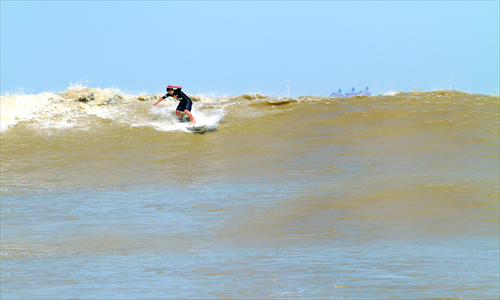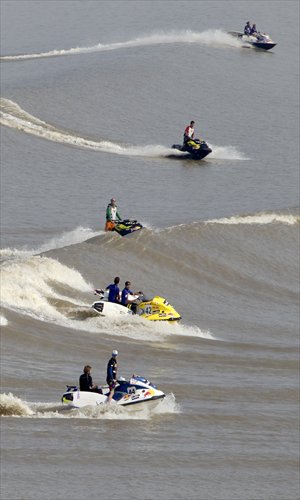Surf's up in China


"The Qiantang Tide is invincible from August 18," wrote Su Shi, one of the greatest Chinese poets from the Northern Song Dynasty (960-1127). Now a bunch of top international surfers are agreeing with him.
There are a few rivers in the world with tidal bores where waves form at certain periods and travel against the current back up the river. Among these are the Savannah River in the US, the Styx in Queensland, Australia and the Severn in England. But only the powerful waves in the Amazon come close to matching the Qiantang River in Zhejiang Province where 3-meter waves can be encountered at the right times.
From October 1 to 3 this year, 16 professional surfers from the US, Australia and Brazil competed on the treacherous waters of the Qiantang River. The competition's chief judge, Glenn Brumage, said that like other surfing events the surfers were judged on how they controlled the board and completed stunts during their rides.
The contest was the first of its kind on the Qiantang River.
A concrete jungle
Surfer Artie Castro from the US summed up the feelings of most of the contestants: "It is very cool to surf in a river running through the city's most built-up area - it's like exploring a concrete jungle."
At its estuary the river is some 100 kilometers wide but in downtown Hangzhou, a few kilometers away, it is just 1 kilometer across. Under the influence of the moon, sea flows up river, peaking to at least 2.5-meter waves on the lunar calendar's August 18 every year, which this year is October 3 in the modern calendar, said Zhou Guangming, chief engineer of Hangzhou Maritime Bureau.
"The waves change constantly in direction and height because the river bed is not flat. So surfers have to react quickly as the waves change," he told the Global Times. "Inexperienced people can easily drown here because the waves are traveling at between five and seven meters a second and are powerful enough to wash a car away."
There were four teams of surfers this year: OE Great Barrier Reef, Roxy Amazon, Gopro Hawaii and Wabsono California. They surfed over a 23-kilometer stretch of the river for an hour, passing under five bridges and avoiding the submerged concrete structures on the way. They ended up in the city itself.
In the contest the surfers drove jet skis to arrive at where the waves begin. While two surfers competed in the contest, their other team members followed them on the jet skis. They swapped places regularly.
"It takes like forever and my legs are exhausted," said Jamie Sterling from team Gopro Hawaii. He said it was normal to surf in the ocean for up to three hours. Because ocean waves were constantly being formed he only spent a few seconds on each wave. On the Qiantang River, however, there is only one wave at a time so he has to try to stay on that wave as long as possible.
"I stayed on one of the waves for five or six minutes, but was also wiped out several times. It is vital to stay balanced, upright and in touch with your teammates," he told the Global Times.
Robert Weaver from Team Roxy Amazon agreed, explaining that they were riding what used to be called "the Silver Dragon," which was formed by the tide colliding with the river along with smaller waves and currents caused by the river banks and underwater formations.
Very dangerous
"Everybody falls off - I've been dumped more than 20 times today," said Weaver. He said that in the water there was low visibility and it was tough trying to swim back to the surface. "Sometimes the current will push you up but more often it will drag you under which can be very dangerous."
When a surfer falls into the water his teammate has to turn the jet ski around to pick him up and take him back to the wave front but with the 2-meter wave stretching across the river it is not that easy.
"It usually takes us between three and 10 minutes - it's time-consuming and affects the scores," Weaver said.
Competition judge Brumage explained there were two types of surfing contest. Power surfing sees surfers using the waves to travel as quickly as possible or having tube rides where a surfer rides on the inside of a breaking wave. New school surfing has surfers performing acrobatic stunts on their boards as they ride the waves, somersaulting or spinning on the board to gain scores.
"It shares many skills with skateboarding but this is more complicated," he said.
On the first two days of the contest OE Great Barrier Reef and Gopro Hawaii were established as the finalists and on the last day, with the waves the highest of the year, the OE team trumped Gopro with better teamwork and more elaborate stunts, Brumage said.
Though he did not win the final, Brumage praised surfer Jamie Sterling from the Gopro team. "He always cut into the waves at the right time, quickly and showed excellent skills."
"Each wave here is a surprise, but I know how to handle them before they take shape because of experience," Sterling told the Global Times. Though he was worn out after the race, he doesn't rate the Qiantang River as a major challenge compared to some other bigger waves he has handled in other parts of the world.
Born in Hawaii in 1982, Sterling began to surf when he was 4, under the guidance of his parents and a brother and sister who all enjoyed surfing. Every day after school he spent two to three hours in the sea near his home and he gradually mastered the art of surfing.
When he was 15 he set out to try surfing in other countries. "I lived on an island, and it only took one hour to drive from one side to the other. It made me want to see the world."
Since then he has participated in major surfing events throughout the world including Australia, Mexico and Chile. As well as competing in four or five major competitions every year he also visits other surfing areas in pursuit of the big waves, the 25-meter giants which he chases from May to October and which have led him to dozens of different localities including Peru, Fiji and Indonesia.
Always in winter
Sterling said winter is his constant companion - it's the season that generates the sort of weather that creates good surfing conditions. He spends most of his five months out of contests flying between the northern and southern hemispheres. "I am always in the winter," he smiled.
In search of great surf he spends weeks checking the Internet, seeking the ideal weather conditions. If he finds a good pattern, he also has to ensure that it will not be life threatening. "I get frustrated sometimes wondering whether I will be able to surf these places and also I think about the question of life or death," he said.
But once he decides on a surfing site, all his anxiety and frustrations vanish. Those 5-meter or higher waves have no fear for him because he has surfed them many times. When he is out there among the waves, Sterling says there is no time to be afraid. There is only time to act.
"The energy that drives the waves is great and even when I am swallowed by them I feel only clean and healthy," he said. Sterling's favorite surfing moments are when he can ride inside a tube with the wave hovering over him just before it breaks.
It's an expensive hobby. Although sponsors cover his costs in the major contests, he has to pay for much of his travel and accommodation himself, especially when he sets out to discover new surfing areas.
He said there are some 50 surfers who travel internationally like him. Many have to earn money from advertising or by winning surfing competitions which usually offer $20,000 for the winner.
"We are like Formula 1 racers - but without the money." Sterling said that big surfs where the waves are more than 5 meters are dangerous and surfers like him who seek these are few and far between. He has suffered in surf, has broken an arm and every other year one of his surfer friends will probably be killed this way.
"I might have to retire in my late 40s, but I hope to keep surfing, even in my 60s," said the 30-year-old.
Robert "Wingnut" Weaver from the Roxy Amazon team found fame years ago when he starred as a surfer in Bruce Brown's 1994 surf movie, The Endless Summer II, a sequel to the 1964 classic The Endless Summer which followed pioneers Mike Hynson and Robert August around the world.
For him and other surfers making money on 3-meter waves is not a problem. There are now many competitions around the world and some offer prize money worth up to $300,000 for a winner.
As well these top-flight surfers can teach others how to surf. "Last month I was in the Maldives and earned $150,000 in seven days teaching a bunch of rich guys on a yacht," Weaver said.
"Surfing is for everyone. Like any sport related to gravity it makes people happy - just as if you rode a bicycle for 20 minutes to the top of a hill and then rode it flat out to the bottom in three to five minutes. It energizes you, it's clean and healthy and it's for free," Weaver said.
The 47-year-old first visited Hong Kong in 1979 and now comes to the Chinese mainland regularly - he has made 10 visits in the past five years. "The beaches in Hawaii and California are always crowded, so I come here to explore new spots for surfing."
Untouched beaches
Recently Weaver went to Hainan Province and discovered several new untouched beaches. "Forests planted by people decades ago under government instructions have prevented many beaches from being overdeveloped and they are ideal for surfing."
Every time he visits Hainan he is accompanied by his friend Nick Zanella, one of the judges of the Qiantang River surfing contest this year. In March Zanella moved from Italy with his wife to live in Hainan.
Zanella's mother came from the Xinjiang Uyghur Autonomous Region in China and he studied Chinese at the Ca' Foscari University of Venice. He has worked for 15 years in journalism writing for surfing magazines.
Zanella started a website in August to report new surfing locations and provides weather forecasts for these sites. Their latest find is a beach on Shengsi Islands in Zhejiang Province, a two-hour boat trip from Shanghai.
"I move to China for two reasons: first to promulgate the surfing culture in this virgin territory; and second is to explore the huge business opportunities behind this," he told the Global Times.
He said though most of the 5,000 to 6,000 daily hits on his website were from foreigners, he has seen more of the Chinese who live near beaches taking up surfing. He pointed to a picture of a 6-year-old native boy with a big smile and a long surf board standing beside a surfing school in Hainan.
"Just like 10 years ago in Taiwan or 25 years ago in Japan, when a bunch of Californian boys went there and showed people what they could do, and got others interested, I believe the Chinese mainland is the next because of us," Weaver said.